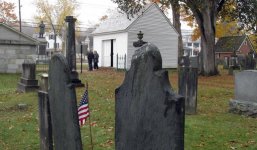Death on display: Honoring a piece of New England history
CHESTER, Vt. (AP) — A Vermont town is offering a reminder of a lost tradition both grim and stately: the New England town hearse.
Horse-drawn hearses, kept in "hearse houses" in town cemeteries and used to carry the deceased from wake to final resting place, were once ordinary in villages across the region. They faded into history with the advent of the automobile and as professional funeral directors replaced the part-time undertakers who shared them.
Now, Chester, population 3,000, has restored its 1830s-era hearse house across Main Street from the town green and returned the community's last horse-drawn hearse, purchased in 1907, to its original location. Together with the 1850 town tomb — still used today to store the bodies of people who die in the winter, when the ground is too frozen for grave-digging — they will become part of a permanent display about how the town once cared for its dead.
The hearse house is a small, windowless, white clapboard building that has stood, deteriorating and unquestioned, for generations at the entrance to Brookside Cemetery, at the center of the town.
"A lot of people thought this was just an insignificant building; they had no idea of the history and the significance of this building, just a little old building, a shed, that was falling down by the cemetery," said lifelong Chester resident Suzy Forlie.
She and Lillian Willis, part of a local organization called Chester Townscape, began working to restore the hearse house in 2014 because they feared the decaying structure, which for years held the cemetery's landscaping equipment, would be torn down.
They already knew that Chester's last community horse-drawn hearse survived; it was on display at the local funeral home.
When they began raising the nearly $50,000 needed to replace the floor, strengthen the foundation, straighten the building and fix the roof so that the house could be used as a public display, Forlie and Willis didn't know that the hearse and the tomb were as much links to the community's past as the graves in the cemetery, where tombstones date to the late 1700s.
Hearse houses, frequently mere sheds on the periphery of cemeteries across New England, are disappearing with the passage of time and the lack of appreciation for the role they once played in everyday life — and death. No one knows for sure how many remain.
In the 1800s and early 1900s, providing funerals was a second job for merchants, frequently furniture makers, said Gregory Camp, executive director of the Vermont Funeral Directors' Association.
"In this area, a lot of towns took responsibility for storing the hearse, and it would be used by the funeral director as needed," Camp said.
Hearse houses were a part of that history.
"Whether they are simple nondescript sheds or intricate Queen Anne-style outbuildings says a lot about how a community approached funerary tradition during a particular period," said Paul Wackrow, who studied hearse houses while a graduate student in historic preservation at the University of Vermont. "Over time, these buildings have become important details in developing a community's sense of place."
The Chester town hearse, with its glass sides, intricate scrollwork and heavy dark-fabric tasseled curtains, was purchased new by the town in 1907. After outliving its usefulness, it was for years on display at a funeral home until it was returned to the hearse house last month. It was last used for a funeral in 1999.
The town tomb, next to the hearse house, still plays a critical role in the community, but the thick stone structure, accessible only with a single brass key that dates to its construction in 1850, also needed restoration. The cement between the granite blocks was repointed and the roof was repaired.
It's hoped the hearse house display, which will include information about 19th-century funeral traditions, such as sharing of "mourning clothes," can remain open whenever the nearby information kiosk is staffed.
"Death was such a prevalent part of everybody's life," Willis said. "It was hard to honor people when everyone was poor."


